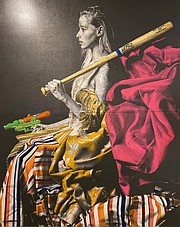“I need to sit on the beach and gaze at the ocean just to rest my eyes.”
This comes from a fellow art lover attending Art Basel Miami, the annual international art exhibit held during early December at Miami Beach, Fla. This year, the event hosted 269 galleries from North America, Latin America, Asia and Europe representing works from early 20th-century modern art to the present.
This is only one of many shows held during what’s colloquially known as Art Miami Week. Other shows include Context, Art Miami, Aqua, Red Dot, Satellite, Untitled and Pulse (and many more) exhibiting artworks for every taste and budget. It is virtually impossible to view all of the artworks on display during this fast-paced, heavily trafficked (at one point there were no Uber or Lyft cars available), late-night week of art and parties.
Miami and Miami Beach are transformed into an art mecca for a few days as gallery owners, artists, curators, and collectors from all over the world gather and take over the city (I ran into Todd Herman, former executive director of the Arkansas Arts Center and now CEO and president of the Mint Museum in Charlotte, N.C.).
Art Basel states that collectors from 70 countries and territories visited, with an overall attendance of 81,000. All of the expected art offerings are included, such as paintings, sculpture, photography, film and ceramics, plus large outdoor installations in parks and on the beach. Performance art, walls of graffiti, lenticular photography, and digital art are represented.
As an artist, I am always searching for new inspiration and am curious to see emerging themes. The expected themes of #metoo, girl power, global warming and Trump were prominent. Paintings of still lifes, cows, hay bales, barns and fishing streams were not.
“As the world becomes more chaotic, artists find comfort by reaching back into history to borrow images and recreate art using new themes, techniques, pigments and materials,” says one gallery owner.
Hunter Queen II by artist Gabriel Moreno, who’s represented by Australian-based Retrospect Galleries, sold quickly at Art Miami for $28,000. The queen, wearing what appears to be yards of silk fabric, holds a baseball bat in her left hand and a toy blaster gun in her right. It is representative of old meets new, with the elegance of fine fabrics painted by the masters juxtaposed with today’s tattooed feminine power. Moreno describes it as “living between the roughness of their tattoos and the finesse of their elegant outlines.”
Two prominent trends were also evident: women artists and figurative black art. Gallery owners and their representatives echoed the same sentiment over and over again: It’s not that they are trying to represent female artists; it is just that their art is better.
Represented by Forum Gallery in New York, Clio Newton’s fictional drawings from her gender composite series are portraits of women naturally rendered into the bodies of men. Newton worked with compressed charcoal on paper to create her drawing Amari.
Newer materials used for making art were abundant. Resins, plastic polymers, Plexiglas, fiberglass and steel were combined in new ways to create exciting works. Represented by Baltimore-based gallery Goya Contemporary, German artist Wilhelm Mundt’s sculpture Trashstone, made of production waste encapsulated in fiberglass and accompanied by a print of the sculpture that looks like a black hole, is one of many examples.
The unexpected is what always catches my eye. New Zealand artist Konstantin Dimopoulos created a beautiful bright blue Buddha made of painted steel barbed wire. It combines peaceful contemplation with material intended to harm and keep people out. The contrast was delightful.
Another example is a silver stainless steel dressing table made of razor blades by artist Tayeba Begum Lipi titled My Mother’s Dressing Table. The Bangladeshi artist uses provocative materials to speak to the violence facing women and references tools used in childbirth in under-developed parts of her home country.
It will be interesting to see how art historians describe this time in the future. In ways it is a re-emergence of the anti-art movement (such as a banana duct-taped to the wall named Comedian by Italian artist Maurizio Cattelan at Art Basel), and in other ways the works are stunning and beautiful.
Perhaps it accurately reflects this moment when our country is deeply divided, not only about political issues but art as well. On the bright side, art is abundant, and there is truly something for every individual taste and budget.
Catherine Rodgers is an artist and writer based in Little Rock.
